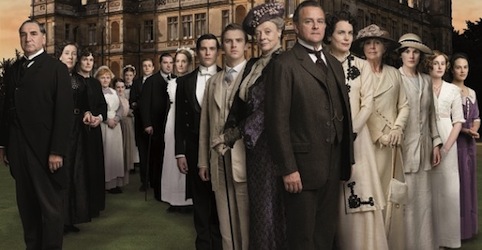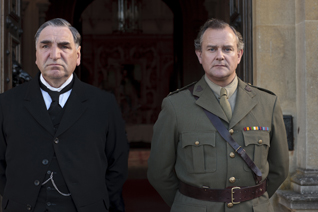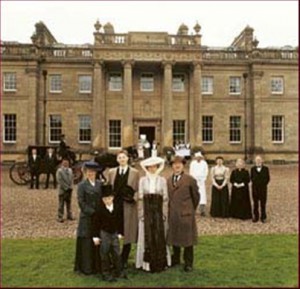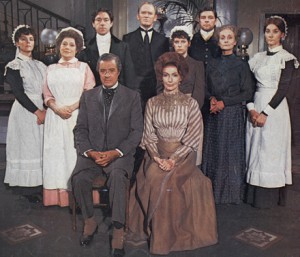When I first sat down to watch Downton Abbey last winter, I didn’t realize that it wasn’t a dramatized novel like so many other Masterpiece programs. But as gay subplots and witty references to technology emerged, I realized that this was in fact a delightfully modern take on what is often represented as a tremendously stuffy period: that tightly laced time between Queen Victoria’s death and the birth of the flappers in the first decades of the twentieth century.
A brilliant British melodrama that exchanges the gasps and eyeliner of American soap operas for raised eyebrows and straight-lipped retorts, Downton Abbey revels in the moments when its characters defy social expectations. The more rules, the more there are to be broken. In order to respond to innumerable shocking events, Downton’s characters have mastered the stare, a facial expression fit for all modern occasions: women in pants, men in beds other than their own, and even monstrously ugly flower arrangements. Stares of longing and stares of horror all find their home in the vivid world of Downton Abbey.
One of Downton’s most influential starers is the head Butler, Mr. Carson. A man who has mastered the art of admiring the elite by looking down his considerable nose, Carson notices anything out of place, from a feather duster to an upstart socialite. Firmly ensconced in a world that he lives to regulate and uphold, Mr. Carson and his employer, Lord Grantham, have perhaps the most to lose by the changing social norms of the early twentieth century. While Carson stubbornly refuses to admit any change, declaring wartime no excuse for substandard service, Lord Grantham views his shifting world with increasing consternation as he questions his own position within it.
While the gazes of these venerable men carry the weight of the English aristocracy on their flattened brows, some of Downton’s other men stare not into the future of Britain but into the eyes of their entranced viewers.There are your somewhat evil, but seductive lookers.
Your charmingly dear, if perhaps a little thick, gawking footman.
And, your, me oh my, hopelessly romantic gazing lovers.
Although such dashing fellows generally spend more time staring at their beloved ladies on screen than looking out to their adoring viewers, their sympathetic eyes keep the audience’s heart beating in time to the sweeping score.
As the women of Downton Abbey are universally gorgeous, it is their stares of horror and disgust that keep the program from sweltering in rosy hues of adoration. Lady Mary’s immaculate eyebrows permit her a look that mingles her haughtiness and insecurity, dissatisfaction and longing for release. Her mother, Cora, manages to look innocently wide-eyed no matter the situation, or her role in it.
Yet all of these looks pale under the force of the Dowager Countess’s piercing glare.
Downton Abbey secures its quality with the performance of Dame Maggie Smith. Youtubers have already suggested various revisions of the program made up entirely of her vitriolic quips. This redoubtable, delightful actress keeps the characters in line and the production laughing at itself with cutting conversation and oblique references to Downton’s considerable melodrama:
“I hate Greek drama, you know, when everything happens off stage.”
No worries there. All are in sight, and all are in mind. Downton Abbey flourishes on the vitality of its ensemble cast, shifting its attentive gaze from one plot to the next.
Although Downton bares considerably less skin than your average prime time drama and makes HBO appear positively grotesque in its excess, the series does not lack for caught-in-the-act moments. In fact, most of the series’ memorable moments happen in bed: dead lovers and caught lovers (not to mention being caught with a dead lover) in one form or another provide most of the drama. And for that matter, the Dowager Countess hardly ever lets anything slip into any place she might consider “off stage.”
Some of the most interesting moments for the unblinking viewers are the movements up and down stairs. The Dowager Countess’s protective interventions into the lives of family servants reveal the softness protected by her prickly crust, and Miss O’Bryan’s penitent bedside attendance to her sick mistress helps viewers to forgive her past cruelties. Initially inscrutable, Lady Mary’s gifts to Anna illustrate her increased attention for others and her romantic sensibility. Even more than the interactions within class boundaries, those between characters of drastically different positions offer insight into the shifting perspectives and emotions of Brits who share more with their maids than their siblings. While the class lines do not blur in these instances, viewers can take pleasure in the way emotions move people up and down the hierarchical stairs.
[As my next point looks more closely into Season Two, those behind-schedule viewers who don’t like their surprises spoilt should cover their eyes and hop over this paragraph to the next.] Representing the many social revolutions of the early twentieth century, Lady Sybil (a women’s rights activist) and Chauffer Branson (an Irish revolutionary) form their “unsuitable” relationship almost entirely outside the boundaries of Downton, instead becoming acquainted in the fittingly new space of mobility: the automobile. They have not gone up or down the stairs to meet each other (like in the housemaid Ethel’s affair with an WWI officer), but have rejected the stairs as the structuring feature of their lives. It is perhaps not insignificant that Lady Mary and Lady Edith must run up the stairs (in a sense bringing the hierarchical staircase with them) when they burst the door of the eloped pair, only to find the couple resting platonically side by side.
The appeal of Downton Abbey extends well beyond the soap operatic satisfaction of a few mésalliances. As “Which character would you be?” quizzes attest, there is something doubly satisfying about watching a program which allows modern viewers to imagine themselves both as a lounging aristocrat and as a hyper-attentive servant, to fantasize about stupendous wardrobes and appreciate the fact that they aren’t dressing other people. A precursor to Downton Abbey, the PBS program Manor House offers viewers the opportunity to live vicariously in another time through a reality TV series which places volunteers in historic recreations ranging from the American frontier to an Edwardian country estate.
Yet, while Manor House’s dramatic renditions of Edwardian life serve to highlight the innumerable differences between life in the twenty-first century and in 1905, Downton Abbey underscores their similarities, bringing history into the present day. Although they may listen to records and wind the motors of their cars, the characters never feel passé. It is appealing to watch a group of people represented as being so situationally different but so philosophically near ourselves. We giggle at the Dowager Countess’s horror of electric lighting (the glare!), while relating to Sybil’s (and several of the servants’) interest in social equality, appreciating that people don’t change so much as their setting does.
Downton Abbey’s second season finale attracted twice the average number of PBS viewers, drawing mainly from that middle age group which neither Sesame Street nor Antique Roadshow tends to captivate—PBS viewership by women 18-34 flew up by 251%. Will the success of Downton lead to a similar slew of period dramas and novel re-writes as we have recently seen with the Jane Austen media craze? (Granted, with its premise of an estate entailed away from a pretty set of daughters, Downton doesn’t steer to far from Pride and Prejudice’s example.)
As these desperate fans haunt the web hoping to whet their appetites on season three leaks, I find myself peering into Downton’s significant lineage, past the thrills and trials of Lady Mary and Mr. Bates, on to that glorious provider of all things British, Historical, and, yes, charmingly Romantic: Masterpiece. For just over forty years, Masterpiece (once Masterpiece Theater) has brought American audiences everything their anglophilic historical hearts could desire. A program that specializes in productions of nineteenth century novels and historical biographies, Masterpiece only occasionally presents programs whose plots are not already easily accessible from Sparknotes. The very mystery of not knowing what comes next in Downton is perhaps its greatest thrill for period drama devotees.
Yet, despite the rarity of programs such as Downton on Masterpiece, Downton’s closest ancestor (excepting screenwriter Julian Fellowes’s other progeny), Upstairs, Downstairs also reached American audiences through PBS’s programming. Set in (very) well-to-do British households over the course a significant portion of the early twentieth century, both of these programs delight in the stereotypes of this blatantly hierarchical period: hot-tempered cooks scold dejected kitchen maids while upright butlers consult languid ladies of the house. Beyond avoiding the significantly less vivid, even to the point of feeling cramped, 1970s cinematography of Upstairs, Downstairs, Fellowes differentiates his new production by moving his aristocratic family out of London into the Yorkshire countryside and more thoroughly evading the Edwardian British life’s dependence on the products and profits of imperialism.
Although many precursors and parodies of Downton Abbey exist, for the most insightful we must look back to the parodies of Upstairs, Downstairs during the early days not just of Masterpiece Theater, but also of Monsterpiece Theater. Greeted by host Alistair Cookie (the original Masterpiece Theater host was named Alistair Cooke), Sesame Street’s minimalist rendition of the production best captures both the movement and the wide-eyed drama of this period.
Emma Schneider is a graduate student in English Literature at Tufts University who revels in catching moments between novels to knead bread, plant seeds, and sip mug after mug of milky Earl Grey tea.
This post may contain affiliate links.












